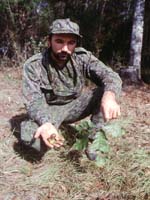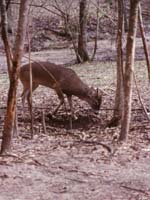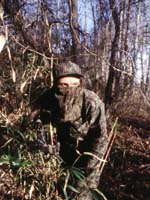
|
Features
|
|
|
|
Books
|
|
|
|
Fun & Games
|
|
|
|
Contact Us
|
|
|
John's Journal... Entry 96, Day 1
Deer Sign that Lies
 EDITOR'S
NOTE: Larry Norton of Pennington, Alabama, a frequent participant
in turkey-calling contests and an avid deer hunter for more than 30 years,
hunts both deer and turkeys each year. Norton lives in a section of the
South where he can take more than 100 deer and six turkeys each year.
A couple of years ago he found what looked like a slam-dunk bag-a-buck
spot where he felt positive a buck deer had visited before and would show
up at again. But after three days of hunting, Norton realized the deer
sign he had read had lied. Often the lands containing the most deer sign
won't produce a buck. Any hunter who continues to hunt where he sees deer
sign may never take the deer making the sign.
EDITOR'S
NOTE: Larry Norton of Pennington, Alabama, a frequent participant
in turkey-calling contests and an avid deer hunter for more than 30 years,
hunts both deer and turkeys each year. Norton lives in a section of the
South where he can take more than 100 deer and six turkeys each year.
A couple of years ago he found what looked like a slam-dunk bag-a-buck
spot where he felt positive a buck deer had visited before and would show
up at again. But after three days of hunting, Norton realized the deer
sign he had read had lied. Often the lands containing the most deer sign
won't produce a buck. Any hunter who continues to hunt where he sees deer
sign may never take the deer making the sign.
 Every
deer hunter must answer the question at some time in his hunting career
and often every season about what to do when deer don't show up at the
deer sign they've left. Where does he look next for the whitetails? Here's
some ideas from experts on why deer don't show up during daylight hours
where they leave sign and some tactics you can utilize for taking these
phantom bucks.
Every
deer hunter must answer the question at some time in his hunting career
and often every season about what to do when deer don't show up at the
deer sign they've left. Where does he look next for the whitetails? Here's
some ideas from experts on why deer don't show up during daylight hours
where they leave sign and some tactics you can utilize for taking these
phantom bucks.
"One season I hunted an area with several white oak trees where I knew the deer were feeding, because I'd spotted acorn hulls and fresh deer droppings under the trees," said Norton. "I also had seen several small trees and even some large trees where bucks had scraped their antlers." For three days, Norton consistently hunted this feeding site in the afternoon. Even though he spotted fresh deer sign in the area every day, he never saw a deer. He concluded the deer fed only at night, either arriving at the trees after he left the woods or feeding in the mornings before he arrived. Norton changed his hunt tactics, reached his stand site just before daylight and hunted until 11:00 a.m. Still Norton saw no deer.
 "I
scouted the surrounding region and found a thicket about 3/4-mile away
from where the deer fed," Norton reported. "A creek ran between the thicket
and the white oak trees, actually closer to the thicket than to the trees.
I found where deer crossed the creek on their way to the acorn trees.
I decided since the early part of deer season that year had had warmer-than-usual
temperatures and deer wouldn't want to move during hot weather, the deer
probably waited until just before dark. Then they would leave the thicket
during the cool of the evening, move to the acorn trees and feed at night."
Norton set his tree stand up where he could see the creek crossing. He
planned to take a buck crossing the creek, headed for the bedding area
before dark. Norton resumed his afternoon hunting pattern, arriving at
his stand about 2:00 p.m. "Just at dusk I started seeing deer coming out
of the thicket and crossing the creek," explained Norton. "In the last
few minutes of shooting time, I spotted a nice-sized 9-point buck approaching
the creek. When he stepped into the creek, I took the buck."
"I
scouted the surrounding region and found a thicket about 3/4-mile away
from where the deer fed," Norton reported. "A creek ran between the thicket
and the white oak trees, actually closer to the thicket than to the trees.
I found where deer crossed the creek on their way to the acorn trees.
I decided since the early part of deer season that year had had warmer-than-usual
temperatures and deer wouldn't want to move during hot weather, the deer
probably waited until just before dark. Then they would leave the thicket
during the cool of the evening, move to the acorn trees and feed at night."
Norton set his tree stand up where he could see the creek crossing. He
planned to take a buck crossing the creek, headed for the bedding area
before dark. Norton resumed his afternoon hunting pattern, arriving at
his stand about 2:00 p.m. "Just at dusk I started seeing deer coming out
of the thicket and crossing the creek," explained Norton. "In the last
few minutes of shooting time, I spotted a nice-sized 9-point buck approaching
the creek. When he stepped into the creek, I took the buck."
Since deer feed nocturnally throughout much of the year, many times they won't appear during daylight hours where you see deer sign. To bag a buck, you'll have to see the deer as he goes to or comes from a feeding area, rather than meeting him at the feeding site.
TOMORROW: Thick-Cover Hunts
Check back each day this week for more about Lying Sign ...
Day 1 -Deer Sign that Lies
Day 2 -Thick-Cover Hunts
Day 3 -Greenfield Hunts
Day 4 -Deer-Movement Patterns
Day 5 -Alternative Food Source